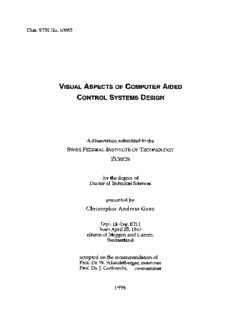
Christopher Andreas Ganz - ETH E-Collection PDF
Preview Christopher Andreas Ganz - ETH E-Collection
ETH Library Visual aspects of computer aided control systems design Doctoral Thesis Author(s): Ganz, Christopher A. Publication date: 1995 Permanent link: https://doi.org/10.3929/ethz-a-001435858 Rights / license: In Copyright - Non-Commercial Use Permitted This page was generated automatically upon download from the ETH Zurich Research Collection. For more information, please consult the Terms of use. Diss.ETHNo. 10963 Visual Aspects of Computer Aided Control Systems Design Adissertationsubmittedtothe SwissFederalInstituteofTechnology Zurich forthedegreeof DoctorofTechnicalSciences presentedby Christopher Andreas Ganz Dipl.El.-Ing.ETH bornApril25,1963 citizenofMeggenandLuzern, Switzerland acceptedontherecommendationof Prof.Dr.W.Schaufelberger, examiner Prof.Dr.J.Gutknecht, co-examiner 1995 hm fffircry i m m pe :ss B RichardStrauss Acknowledgments Inthe round ofpeoplewho helpedme in mypursuit forthis thesis, Ifirstwantto express mygratitudetoProf. Schaufelbergerforhis supportduringthiswork. Ialso wanttothankProf. Gutknechtforhiswillingness to co-referee thisthesis. Ialso feel muchobliged toProf.Mansour,who gaveme theopportunitytoworkattheAuto¬ maticControlLab. Anotherword ofthankgoes to Dr. Maier ofABB forthe organization ofthe funds whichfinancedpartsofthisthesis.Healsointroducedmetothefieldofsoftwareengi¬ neering,anotherreasonwhyheappearsonthispage. IwouldalsoliketoincludemycolleaguesattheAutomaticControlLaboratoryinmy thanksfortheircontinuoussupport.PeterKolbdeservesspecialmention.Heistheco¬ authoroftheLeporellopackagepresented inthesecondpartofthisthesis,Iamvery muchindebtedtohimforhiswork.HeandMartinRicklialsocontributedtothefruit¬ ful discussions in thebeginning ofthis project. Not always as fruitful, butmostly entertaining were the discussionswithJanuszMilek,Markus Kottmannand Chri- stophEck. Thispagewouldnotbecompletewithoutthementionofmanypersonalfriends,who alwaysdidagoodjobindistractingmymindfromtheproblemsofthisthesis.Iwould especially liketomentionmyfriends ofByfvCquoxx(sic!),BeatandBarbaraHuber andDeniseGraf. Finally,Iwanttothankmyparentsforalltheirsupportduringmylongeducation.Itis tothem,thisthesisisdedicated. i Leer Vide Empty - - Hi Contents Abstract 1 Kurzfassung 2 1. Introduction 5 1.1. Pictures 5 1.2.VisualEngineering 7 1.3. GraphicsinControlEngineering 8 1.4. StructuredVisualControlSystemsDesign 10 1.5.Scope,Contributionsand Organization 11 1.5.1.Scope 11 1.5.2. Contributions 12 1.5.3. Organization 12 2. VisualAspects ofSoftwareinAutomatic Control 15 2.1.ScientificVisualization 16 2.1.1.One-DimensionalDisplays 17 2.1.2. Two-DimensionalPlots 17 2.1.3.Three-DimensionalPlots 19 2.1.4. TheUseoftheFourthDimension 20 2.1.5. Summary 22 2.2.VisualProgramming 23 2.2.1. ControlFlowDescriptions 26 2.2.2. DataFlowDescriptions 30 2.2.3. Summary 34 2.3.Tools 35 2.3.1.SystemSpecs 35 2.3.2.Simulink 38 2.3.3. BlockSim 40 2.3.4. GenT 42 2.3.5. LabVIEW 45 2.4. TextorPictures? 48 2.4.1.VisualLanguagesDiscussion 51 2.4.2. Summary 53 3. Leporello: Visual Representationofthe DesignProcess 55 3.1. TheLeporelloProject 56 3.2. TheDesignCycle 58 3.2.1. ActionTreeBasics 58 IV 3.2.2.Tree-structuredDataBases 60 3.2.3. GraphTheory 61 3.3. BasicDataStructuresinLeporello 62 3.3.1.TheObjectOrientedApproach 63 3.3.2. ControlDataObjects 63 3.3.3.ParameterLists 66 3.3.4.Algorithms 67 3.3.5.AlgorithmExecution 69 4. TheActionTree: Functionality andObject Definition 71 4.1.Algorithm NodeExecution 72 4.1.1.SelectingandExecutinganAlgorithm 72 4.1.2.ExecutionofanAlgorithm onDifferentCDCNodes 78 4.1.3. CreationofMulti-objectNodes 81 4.1.4.ApplicationofanAlgorithmtoaMulti-objectNode 83 4.2.ManagingMulti-objectNodes 90 4.2.1.ExtractaSubsetNodefromaMulti-objectNode 90 4.2.2.MergeSubsetNodes 92 4.3. ManagingTreeComplexity 93 4.3.1. CopyandPasteOperations 93 4.3.2.DeleteNodes 95 4.3.3.MarkDeletedSubtree 95 4.4.AutomaticSubtreeExecution 96 4.4.1.MakeSubtreeConsistent 97 4.4.2.HierarchicalAlgorithm 99 4.5.SpecialTasks 104 4.5.1.ParameterSweep 105 4.5.2.ParameterOptimization 105 4.6. HierarchicalSystems 107 4.6.1.HierarchicalSystems ClassDefinition 107 4.6.2.BlockDiagramEditorandActionTreeOperations 107 5. Application Ill 5.1.PlantandHardwareDescription 112 5.1.1. ElectronicLaboratoryBalance 112 5.1.2. ComputerHardware 113 5.2.WorkingwithLeporello 114 5.2.1. LeporelloUserInterface 114 5.2.2. BalanceMeasurementsandInteractiveControllerDesign 116 .... 5.2.3.IdentificationofaContinuous-timeModel 121 5.2.4. StateFeedbackControllerDesign 123 5.2.5. Discrete-timeARX-modelIdentification 125 5.2.6.Remarks 130 V 6. Conclusionsand FurtherWork 131 6.1. Conclusions 131 6.1.1.ScientificVisualization 131 6.1.2.VisualLanguages 132 6.1.3.VisualControlSystemsDesigninLeporello 132 6.2. FurtherWork 133 6.2.1. LeporelloConceptExtensions 133 6.2.2.FutureLeporelloDevelopment 134 Appendix A. ListofavailableLeporelloalgorithms 135 B.Actiontreenodestatesandpictures 139 C.Objectsyntaxandnamingconventions 141 D.ManagingDynamicalDataStructures 143 D.l.VariableSizeDataStructures 143 D.2. Garbagecollection 145 Glossary 147 Bibliography 151 Softwarereferences 154 Index 155 Abstract 1 Abstract The use ofa computerto solve control engineeringproblems is state ofthe art in today'sautomaticcontrolcommunity.Numeroussoftwarepackageshavebeendevel¬ oped inrecentyears.Afewofthem arecommerciallyavailabletodayand some are even regarded as a de-facto standard in computer aided control systems design (CACSD). The advantage ofCACSD software is the largenumberand the quality ofthepro¬ vided algorithms. However, developmentsconcentrated onnumericalratherthanon userinterfaceaspects. Untilveryrecently, mostofthesepackagesrequiredtextually enteredcommandsandprovidedrudimentarytwo-dimensionallinegraphs. Recentdevelopmentsincomputersciencehaveremoved thelimitations ofoldersys¬ tems.Dataandsoftwarevisualizationareappliedtovariousfieldsofscienceandengi¬ neering, andmostcomputerscanbeoperatedusingagraphicaluserinterface. Inthisthesis,weexploretheapplicationofgraphicalmethodsincomputeraidedcon¬ trolsystemsdesign.Withincreasingemphasiswewilldiscussthefollowingaspectsof visualinterfaces: - Datavisualization: Dataresultingfromeitherexperimentsoralgorithmexecution (i.e. computersimulations) are mostlydisplayed intwodimensionalgraphs. The useofmore complex,higherdimensionaldisplaysisdiscussed. Examplesofthree dimensionaldisplays,movingdatavisualizationand interactivemanipulation of algorithmsatruntimearepresented. - Visual programming: The technique to show the interaction ofsub-systems in blockdiagramsiswellknownincontrolengineering.Theirsimilaritytovisualpro¬ gramminglanguageshelpsus tonotonlydisplaydatavisually,butalsoto design computerprograms orcontrollerimplementationsusingvisualmethods.Available visualprogramminglanguagesarepresentedincontrolapplications. - Graphicaluser interface to the control systems design cycle:As we have seen above, theemphasisoftoday's CACSDpackages is intheavailabilityofsophisti¬ catedalgorithms.Littleornoemphasis hasbeenputonthe supportofthedesign cycle as awhole. With the 'Leporello' packagewe present a new softwaretool, whichvisualizesalltheworkdoneduringadesignsession. Allalgorithmswhich wereusedtoreachasuccessfulcontrollerimplementationarestoredanddisplayed inthe 'actiontree',togetherwith theirparametersand results. Intermediate data itemsarecollected consistentlyincontroldataobjects. Thepossibilitytouseexter¬ nalpackagesfortheimplementationofalgorithms allowsafullygraphicaluserin¬ terface for control systems engineering using the whole range of algorithms providedbyotherapplications. Themethodsandtoolspresentedareusedtosolveoneoftheexampleplantsfromthe studentlaboratory. Byusingthe'Leporello'toolwedemonstrate itsuseandrangeof application. 2 Kurzfassung DieVerwendungvonComputern zurLosungvonregelungstechnischenProblemen istheutzutage Stand der Technik. Mehrere Softwarepakete wurdenin letzter Zeit entwickelt.Einigevonihnensindheutekommerziellerhaltlich,unddavonhabensich einige zu einem faktischen Standard im Computer-unterstutzten Reglerentwurf entwickelt. DieVorteilederheuteverfiigbarenProgrammpaketeliegenhauptsachlichindergros- sen Vielfalt und Qualitat der unterstiitzten Algorithmen. Bei deren Entwicklung wurdejedochdemEntwurfderBenutzerschnittstellewenigBeachtunggeschenkt.Die Moglichkeiten dieserPaketeerschopften sichbisvor kurzem in alphanumerischen BefehlseingabenundzweidimensionalenLiniengraphen. NeusteEntwicklungenim BereichderComputertechnik haben dietechnischen Ein- schrankungen fruhererSystemebeseitigt. Daten-und Softwarevisualisierunghat in vielen GebietenEinzug gehalten, die graphische Benutzerschnittstellehat sich zur BedienungvonComputerndurchgesetzt. IndieserArbeitwerdendieMoglichkeitenderAnwendunggraphischerMethodenim Bereich des rechnerunterstiitzten Reglerentwurfes untersucht. Mit zunehmender GewichtungwerdendiefolgendenBereichediskutiert: - Datenvisualisierung:MesswerteoderResultatevonAlgorithmen(z.B.Simulations- resultate) werdenheutemeist in zweidimensionalen Graphen dargestellt. Durch dieVerwendunghohererDimensionenkannjedochanfallendenDatensatzenmehr Informationentnommenwerden. Dreidimensionale oderanimierte Darstellungen sowiedieinteraktiveBeeinflussungvonAlgorithmenzurLaufzeitwerdenanhand vonBeispielengezeigt. - Graphische Programmierung: Die Verwendung von Blockdiagrammen zur DarstellungderRelationen zwischen Teilsystemenisteine demRegelungstechni- kervertrauteMethode. Die Ahnlichkeit dieserDiagramme zu graphischenPro- grammiersprachen legt die Anwendung solcher Sprachen zum Entwurf von regelungstechnischenAlgorithmenundReglerimplementationennahe.Verfugbare UmgebungenzurgraphischenProgrammierungwerdenjeweilsmitBeispielenaus derRegelungstechnikvorgestellt. - Graphische BenutzerschnittstellefureinenintegralenEntwurfsprozess:Wieweiter obengezeigt,liegtdasSchwergewichtbeidenheuteerhaltlichenSoftware-Paketen aufderImplementationausgereifterAlgorithmen.WenigodergarkeineBeachtung wird dabei der Unterstiitzung des gesamten Entwurfszyklus geschenkt. Das in dieser Arbeit vorgestellte Programmpaket 'Leporello' visualisiert diesen Entwurfsprozess.SamtlichezurLosungeinesProblemsverwendetenAlgorithmen werdenzusammenmitdenAlgorithmusparameternunddenresultierendenDaten gespeichertundim'ActionTree'(Arbeitsbaum)dargestellt.AnfallendeDatenwer¬ denjeweilsin regelungstechnischen Datenobjektenzusammengefasstund konsis-
Description: